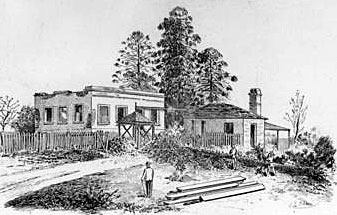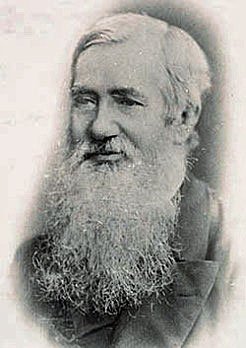
Sketch of the Brisbane residence 'Dara' by E. Bihan (c.1890)
[John Oxley Library, State Library of Queensland]

Sketch of the Brisbane residence 'Dara' by E. Bihan (c.1890)
[John Oxley Library, State Library of Queensland]
Historical and Technical Documentation by Geoffrey Cox1
© OHTA 2009, 2012 (last updated July 2012)
Although the major Christian denominations had established themselves in the Moreton Bay District by the time Queensland was officially proclaimed a separate colony from New South Wales on 10 December 1859, it appears that there were still no pipe organs installed in Queensland churches by this time. At least one small pipe organ, however, had reached Brisbane before this - perhaps as early as the mid 1840s. This was an instrument advertised on 4th and 7th May 1859, to be sold by auction on Thursday 19th May amongst the household furniture of Mr W.A. Duncan.
THURSDAY, 19TH INSTANT EXTENSIVE SALE OF FURNITURE H. Bulgin has received instructions from W.A. Duncan, Esq [including] A first-rate London built Finger ORGAN, |
William Augustine Duncan (1811-85) was a Scottish Catholic who had migrated to New South Wales as a schoolteacher in 1837. He was appointed Customs Officer at Moreton Bay in 1846, and became the founding President of the School of Arts in Brisbane (1850-54). Duncan remained in Brisbane until May 1859, when he returned to Sydney as the New South Wales collector of customs, dying there in 1885.3 In Brisbane, Duncan was also the first Choir Director of St Stephen's Catholic Church in Brisbane.

Portrait of W.A. Duncan by an unknown photographer
[Photograph: State Library of New South Wales]
Upon his arrival in Brisbane, Duncan and his family were accommodated at first in a small cottage at the corner of Queen and Wharf Streets,4 but in 1850 he built his own house 'Dara' in Fortitude Valley, a flat-roofed one-story building made entirely of mud. The location was known for a time as 'Duncan's Hill', and Duncan's name is perpetuated to the present day in nearby Duncan Street. 'Dara' was sold upon Duncan's return to Sydney in 1859 to Mr Patrick Mayne. Bishop Quinn lived at 'Dara' from the time of his arrival in 1861, and purchased the house and the two-acre property from Mayne in 1864.5 Old 'Dara' was later replaced by a new residence. The new 'Dara' was in turn demolished in 1928 to make way for the proposed Holy Name Cathedral, which was never completed.
The sale of Duncan's furniture was clearly associated with his move back to Sydney. In an expanded form of the advertisement for the sale of Duncan's furniture on 7th May 1859, there is also reference to 'a very choice selection of organ, piano, and flute music.'6 One day before the auction, however, the expanded advertisement was reprinted, but with the reference to the finger organ removed.7
It is possible that the instrument was sold prior to auction, or that Duncan decided not to sell it and took it back with him to New South Wales. If the organ remained in Queensland, it could perhaps have been the one later owned by Mr T.J. Brown of Townsville, or the one that appeared around 1866 at St Stephen's Presbyterian Church, Ipswich, or the instrument set up for sale in the School of Arts, Brisbane in 1873, or the one installed in 1874 at Holy Trinity Church, Fortitude Valley. But there is too little known about Duncan's instrument to provide a strong connection with any of these.
1 An earlier version of the historical documentation presented here appeared in 2009 as: Geoffrey Cox, 'W.A. Duncan and the Moreton Bay Settlement: New Evidence for the Earliest Pipe Organ in Queensland?' OHTA News, vol. 33, no. 4 (October 2009), pp. 24-29.
2 The Moreton Bay Courier (Wednesday 4 May, 1859), p. 3. The advertisement appeared in expanded form in The Moreton Bay Courier (Saturday 7 May, 1859), p. 3.
3 Michael Roe, 'Duncan, William Augustine (1811-1885),' Australian Dictionary of Biography, vol. 1 (Carlton: Melbourne University Press, 1966), pp. 335-37.
4 John H.C. McClurg, Historical Sketches of Brisbane (Brisbane: Library Board of Queensland & the Royal Historical Society of Queensland, 1975), pp. 65-66.
5 Denis W. Martin, The Foundation of the Catholic Church in Queensland (Toowoomba: Church Archivists' Society, 1988), p. 146, 151, 153, 156-58.
6 The Moreton Bay Courier (Saturday 7 May, 1859), p. 3.
7 The Moreton Bay Courier (Wednesday 18 May, 1859), p. 3.